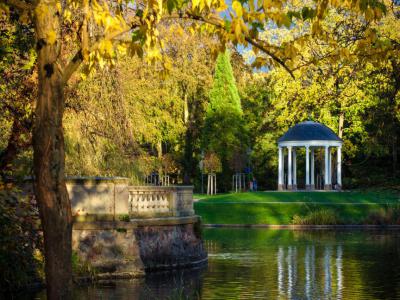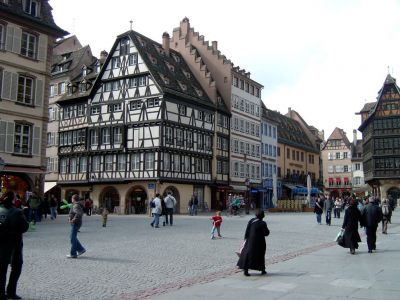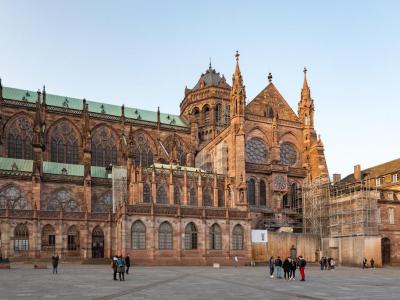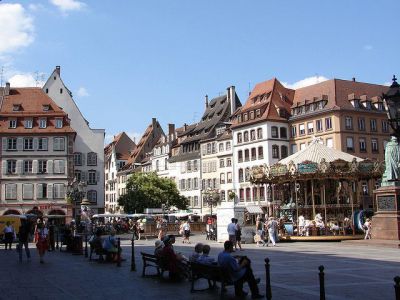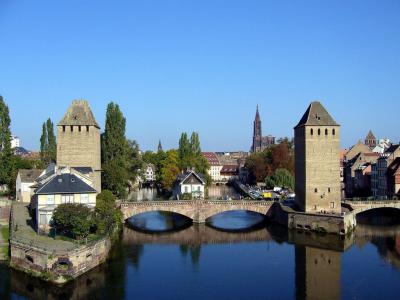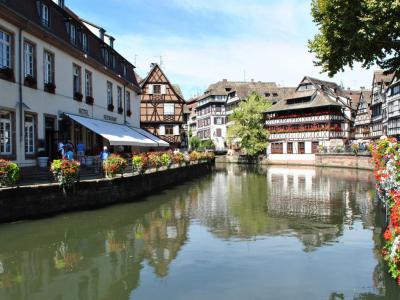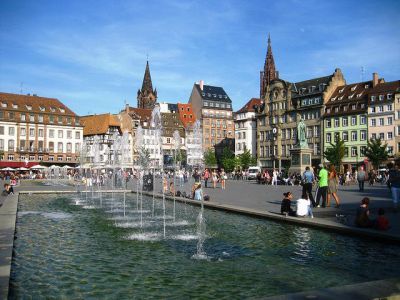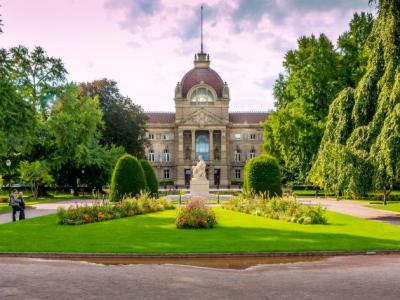Custom Walk in Strasbourg, France by teresaderojas_573c7 created on 2025-04-14
Guide Location: France » Strasbourg
Guide Type: Custom Walk
# of Sights: 9
Tour Duration: 4 Hour(s)
Travel Distance: 8.5 Km or 5.3 Miles
Share Key: U4SD6
Guide Type: Custom Walk
# of Sights: 9
Tour Duration: 4 Hour(s)
Travel Distance: 8.5 Km or 5.3 Miles
Share Key: U4SD6
How It Works
Please retrieve this walk in the GPSmyCity app. Once done, the app will guide you from one tour stop to the next as if you had a personal tour guide. If you created the walk on this website or come to the page via a link, please follow the instructions below to retrieve the walk in the app.
Retrieve This Walk in App
Step 1. Download the app "GPSmyCity: Walks in 1K+ Cities" on Apple App Store or Google Play Store.
Step 2. In the GPSmyCity app, download(or launch) the guide "Strasbourg Map and Walking Tours".
Step 3. Tap the menu button located at upper right corner of the "Walks" screen and select "Retrieve custom walk". Enter the share key: U4SD6
1) Parc de l'Orangerie (must see)
The Parc de l'Orangerie is a public park situated in Strasbourg. Positioned across from the Palais de l'Europe and in proximity to the other European establishments within the Orangerie district, part of the Neustadt area, it spans an expanse of 26 hectares.
Historical accounts differ regarding the origins of Parc de l'Orangerie. Some assert that it was planted in 1801 following designs by André Le Nôtre, while others argue that in 1735, the plan titled "Plan de Strasbourg" was conceived by the captain engineer Antoine du Chaffat.
During the period of the French Revolution, the city of Strasbourg came into possession of a hundred and forty orange trees seized from the Château de Bouxwiller by the Republicans. In 1804, the current Joséphine pavilion, named in honor of Joséphine de Beauharnais (Empress of the French and Napoleon Bonaparte's wife), was erected by Pierre-Valentin Boudhors to house these trees.
The Parc de l'Orangerie underwent significant expansion during the German era, coinciding with the industrial and artisanal exhibition in Strasbourg in 1895. This was when the artificial lake and its accompanying waterfall were created. The park became an integral part of the Neustadt. In 1929, the Joséphine pavilion was officially recognized as a historical monument, while the entire park received this designation in 1993.
A fire in 1968 ravaged the Joséphine pavilion, which was then meticulously reconstructed to mirror its original form and repurposed for cultural activities. In 2013, both the main thoroughfare of the park, Allée de l'Orangerie Joséphine, and the Allée des Platanes underwent redesign, accompanied by new lighting installations.
At present, merely three orange trees remain, sheltered within the park's accessible greenhouses on specific dates for public viewing. The Orangerie stands as a cherished locale for Strasbourg locals, offering a mini-farm, a stork reintroduction center, a bowling alley, a children's car circuit named "L'École de Conduite," multiple play areas, sports facilities, and petanque courts. Furthermore, visitors can rent boats for lake navigation. Numerous fountains, statues, and kiosks adorn the park's pathways, and a number of ice cream parlors have set up stands in the vicinity.
Tip:
Check out the flamingos in the mini zoo – a beautiful splash of color!
Historical accounts differ regarding the origins of Parc de l'Orangerie. Some assert that it was planted in 1801 following designs by André Le Nôtre, while others argue that in 1735, the plan titled "Plan de Strasbourg" was conceived by the captain engineer Antoine du Chaffat.
During the period of the French Revolution, the city of Strasbourg came into possession of a hundred and forty orange trees seized from the Château de Bouxwiller by the Republicans. In 1804, the current Joséphine pavilion, named in honor of Joséphine de Beauharnais (Empress of the French and Napoleon Bonaparte's wife), was erected by Pierre-Valentin Boudhors to house these trees.
The Parc de l'Orangerie underwent significant expansion during the German era, coinciding with the industrial and artisanal exhibition in Strasbourg in 1895. This was when the artificial lake and its accompanying waterfall were created. The park became an integral part of the Neustadt. In 1929, the Joséphine pavilion was officially recognized as a historical monument, while the entire park received this designation in 1993.
A fire in 1968 ravaged the Joséphine pavilion, which was then meticulously reconstructed to mirror its original form and repurposed for cultural activities. In 2013, both the main thoroughfare of the park, Allée de l'Orangerie Joséphine, and the Allée des Platanes underwent redesign, accompanied by new lighting installations.
At present, merely three orange trees remain, sheltered within the park's accessible greenhouses on specific dates for public viewing. The Orangerie stands as a cherished locale for Strasbourg locals, offering a mini-farm, a stork reintroduction center, a bowling alley, a children's car circuit named "L'École de Conduite," multiple play areas, sports facilities, and petanque courts. Furthermore, visitors can rent boats for lake navigation. Numerous fountains, statues, and kiosks adorn the park's pathways, and a number of ice cream parlors have set up stands in the vicinity.
Tip:
Check out the flamingos in the mini zoo – a beautiful splash of color!
2) Place de la Cathédrale (Cathedral Square)
The Cathédral Square lies just north and west of the Strasbourg Cathedral. It is one of the best places to admire the exterior of the magnificent Rayonnant Gothic cathedral. The north side of the building, adjacent to the square, has some of the most impressive details and ornamentation.
The cathedral was begun in 1015, with significant contributions by architect Erwin von Steinbach starting in 1277. Work was continued by his son and then his grandson. The building was completed in 1439.
The impressive western face of the cathedral is best viewed from the square. Here you'll get a great view of the rose window. The three west portals each have particular themes to their decoration. The left shows the infancy of Christ, the central depicts the redemption, and the right shows the Last Judgement. The sculptures date to the 13th century.
As seen from the Cathedral Square, one of the most prominent features is the octagonal bell tower and spire. It is located on the northwest corner of the building. Despite plans for two towers, the building was completed with only one. The tower initially featured a Virgin Mary statue on the top, but this was replaced by a fleuron ornament in 1488.
At 142 meters (466 feet), the cathedral was the world's tallest building for 277 years, from 1647 until 1874. Today it is the sixth-tallest church in the world and the tallest building anywhere built in the Middle Ages.
The northern and western sides of the Cathedral Square, opposite the church, are home to various boutique shops and cafés. The square connects to the Frères Street on the east and Mercière Street on the west.
The cathedral was begun in 1015, with significant contributions by architect Erwin von Steinbach starting in 1277. Work was continued by his son and then his grandson. The building was completed in 1439.
The impressive western face of the cathedral is best viewed from the square. Here you'll get a great view of the rose window. The three west portals each have particular themes to their decoration. The left shows the infancy of Christ, the central depicts the redemption, and the right shows the Last Judgement. The sculptures date to the 13th century.
As seen from the Cathedral Square, one of the most prominent features is the octagonal bell tower and spire. It is located on the northwest corner of the building. Despite plans for two towers, the building was completed with only one. The tower initially featured a Virgin Mary statue on the top, but this was replaced by a fleuron ornament in 1488.
At 142 meters (466 feet), the cathedral was the world's tallest building for 277 years, from 1647 until 1874. Today it is the sixth-tallest church in the world and the tallest building anywhere built in the Middle Ages.
The northern and western sides of the Cathedral Square, opposite the church, are home to various boutique shops and cafés. The square connects to the Frères Street on the east and Mercière Street on the west.
3) Cathédrale Notre-Dame de Strasbourg (Strasbourg Cathedral) (must see)
Until 1874 the Strasbourg Cathedral was the world's tallest building; today it is the 6th tallest church and its tower dominates the Strasbourg skyline.
Described by Victor Hugo as a "gigantic and delicate marvel", and by Goethe as a "sublimely towering, wide-spreading tree of God", the cathedral is visible far across the plains of Alsace and can be seen from as far off as the Vosges Mountains or the Black Forest on the other side of the Rhine. Sandstone from Vosges, used in construction, gives the cathedral its characteristic pink hue.
The building took many centuries to finish and has three distinctive styles. Its crypt, dating back to 1015, has been expanded over the centuries. The North Tower, built in 1439, stands 142 meters high and on a clear day you can see for over 30 kilometers from its observation deck. The Lawrence Portal in the North Transept was finished in 1505 in a markedly post-Gothic, early-Renaissance style.
Most of the statues in the cathedral are copies of the originals kept at the Oeuvre Notre-Dame Museum. The stunning Astronomical Clock, built in 1843 to replace an earlier clock, is 18 meters high and is one of the largest in the world.
The clock show, including a 30-minute movie presentation with English subtitles, is at 12:30 pm in the summer, but you must be there at around 11:30 am to book your entry at the back door of the Cathedral, since the places are limited. Climbing up the tower is not difficult, as long as you can manage 330 steps - and it's worth the effort!
Described by Victor Hugo as a "gigantic and delicate marvel", and by Goethe as a "sublimely towering, wide-spreading tree of God", the cathedral is visible far across the plains of Alsace and can be seen from as far off as the Vosges Mountains or the Black Forest on the other side of the Rhine. Sandstone from Vosges, used in construction, gives the cathedral its characteristic pink hue.
The building took many centuries to finish and has three distinctive styles. Its crypt, dating back to 1015, has been expanded over the centuries. The North Tower, built in 1439, stands 142 meters high and on a clear day you can see for over 30 kilometers from its observation deck. The Lawrence Portal in the North Transept was finished in 1505 in a markedly post-Gothic, early-Renaissance style.
Most of the statues in the cathedral are copies of the originals kept at the Oeuvre Notre-Dame Museum. The stunning Astronomical Clock, built in 1843 to replace an earlier clock, is 18 meters high and is one of the largest in the world.
The clock show, including a 30-minute movie presentation with English subtitles, is at 12:30 pm in the summer, but you must be there at around 11:30 am to book your entry at the back door of the Cathedral, since the places are limited. Climbing up the tower is not difficult, as long as you can manage 330 steps - and it's worth the effort!
4) Place Gutenberg (Gutenberg Square) (must see)
One destination that should be on your “must-see” list is the Place Gutenberg which lies in the center of medieval Strasbourg, not far from the Cathedral.
This large square is a favorite for locals and tourists alike as it has a lot of excellent cafes and restaurants. The Chamber of Commerce building occupies one side of the square and is easily recognizable with its Renaissance style, but with the sloping roof that is typical of Alsace, where winter snow is a way of life.
There is a 16th-century hotel on the square where Arthur Young was staying when revolutionists destroyed the city’s magistrates records and where today art exhibitions are held on the ground floor. Another attraction is the flea markets that often set up around the statue in the center of the square.
The statue is, quite obviously, dedicated to Johannes Gutenberg; it was sculpted by David d’Angers in 1840 and features the famous printer holding a piece of parchment on which is inscribed the words “Et la lumière fut” (And behold, there was light) from the Book of Genesis. Around the base of the statue, bas reliefs depict notable scenes from Gutenberg’s life.
Not many people know that apart from being the inventor of the first mechanical, movable printing press in Europe in 1439 and the publisher of the Gutenberg Bible in 1455, Gutenberg lived in Strasbourg between 1434-44, where he was an apprentice goldsmith, set to follow in his father’s footsteps.
This large square is a favorite for locals and tourists alike as it has a lot of excellent cafes and restaurants. The Chamber of Commerce building occupies one side of the square and is easily recognizable with its Renaissance style, but with the sloping roof that is typical of Alsace, where winter snow is a way of life.
There is a 16th-century hotel on the square where Arthur Young was staying when revolutionists destroyed the city’s magistrates records and where today art exhibitions are held on the ground floor. Another attraction is the flea markets that often set up around the statue in the center of the square.
The statue is, quite obviously, dedicated to Johannes Gutenberg; it was sculpted by David d’Angers in 1840 and features the famous printer holding a piece of parchment on which is inscribed the words “Et la lumière fut” (And behold, there was light) from the Book of Genesis. Around the base of the statue, bas reliefs depict notable scenes from Gutenberg’s life.
Not many people know that apart from being the inventor of the first mechanical, movable printing press in Europe in 1439 and the publisher of the Gutenberg Bible in 1455, Gutenberg lived in Strasbourg between 1434-44, where he was an apprentice goldsmith, set to follow in his father’s footsteps.
5) Pont Couverts (Covered Bridges) (must see)
To protect the ancient city of Strasbourg, the Covered Bridges were constructed in the 1200s. There are three bridges crossing the River Ill. Additionally, there are four defensive towers set up between them.
In the late 1600s, the bridges were covered with wooden roofs. These were intended to cover soldiers and defenders who were stationed on the bridges during times of war. The covers were removed in 1784, but the name "Covered Bridges" has stuck.
While the bridges and towers remain, their task of defending the city was taken by the nearby the Vauban Dam. The Vauban Dam is the combination bridge and weir just west of the Covered Bridges.
If you want some postcard-perfect photos, stop by the Covered Bridges just after dark. The bridges and city are lit spectacularly. The best place to view and photograph the Covered Bridges is from near or on the Vauban Damn.
In the late 1600s, the bridges were covered with wooden roofs. These were intended to cover soldiers and defenders who were stationed on the bridges during times of war. The covers were removed in 1784, but the name "Covered Bridges" has stuck.
While the bridges and towers remain, their task of defending the city was taken by the nearby the Vauban Dam. The Vauban Dam is the combination bridge and weir just west of the Covered Bridges.
If you want some postcard-perfect photos, stop by the Covered Bridges just after dark. The bridges and city are lit spectacularly. The best place to view and photograph the Covered Bridges is from near or on the Vauban Damn.
6) Petite France (Little France) (must see)
Petite France is an area in Strasbourg that is often called the Venice of the North because of its narrow streets and canals. It is a delightful area to visit as it takes you back to Medieval Strasbourg.
In the Middle Ages the beautiful half-timbered houses were the homes of fishermen, millers and tanners, and indeed many of the streets bear the names of the crafts carried out: Millers Street, Tanners Ditch and Lace Street, for example. The houses have the traditional tiered sloping roofs and hides were once hung up to dry on the topmost rafters.
In the late 15th century a hospice was built on the island for small-pox victims and later for French soldiers suffering from syphilis – which the Germans called it “French Disease” to stop the local girls from sleeping with the soldiers! The area became known as “Little France”, more out of derision than patriotism. The name stuck and today it is one of the most expensive quarters in the city.
Just to the west of Petite France, you can visit the Barrage Vauban – a weir that crosses the River Ill. It was built in 1686 from the plan by Marquis Vauban. The weir has two stories with wonderful sculptures on the main level, as well as a roof terrace where you can take superb photos of Petite France.
Why You Should Visit:
The most romantic neighborhood in Strasburg by far, especially at nightfall. There are also plenty of shops and places to try authentic French dishes. Places are open late and buildings are lit up after dark.
Tip:
Walk around here early in the morning if you wish to get photos without thousands of tourists in your shots. If you have issues walking on cobblestones, you can also take the boat or a little touristic train that goes around the Petit France.
In the Middle Ages the beautiful half-timbered houses were the homes of fishermen, millers and tanners, and indeed many of the streets bear the names of the crafts carried out: Millers Street, Tanners Ditch and Lace Street, for example. The houses have the traditional tiered sloping roofs and hides were once hung up to dry on the topmost rafters.
In the late 15th century a hospice was built on the island for small-pox victims and later for French soldiers suffering from syphilis – which the Germans called it “French Disease” to stop the local girls from sleeping with the soldiers! The area became known as “Little France”, more out of derision than patriotism. The name stuck and today it is one of the most expensive quarters in the city.
Just to the west of Petite France, you can visit the Barrage Vauban – a weir that crosses the River Ill. It was built in 1686 from the plan by Marquis Vauban. The weir has two stories with wonderful sculptures on the main level, as well as a roof terrace where you can take superb photos of Petite France.
Why You Should Visit:
The most romantic neighborhood in Strasburg by far, especially at nightfall. There are also plenty of shops and places to try authentic French dishes. Places are open late and buildings are lit up after dark.
Tip:
Walk around here early in the morning if you wish to get photos without thousands of tourists in your shots. If you have issues walking on cobblestones, you can also take the boat or a little touristic train that goes around the Petit France.
7) Place Kléber (Kleber Square) (must see)
It is well worth taking time to visit the Place Kleber which is the biggest square in the heart of the city’s commercial district. The square has been a central meeting place since it was laid out in the 14th century and it took its name in 1840 after the General Jean Baptiste Kleber, whose statue stands in the center of the square. The general served in Napoleon’s army during the campaign in Egypt in 1798 and 1799. The statue was erected in 1838 by Philippe Grass.
When Napoleon returned to Paris, he named the Kleber Commander of the French Forces. Kleber was assassinated in 1800 in Cairo. His body was repatriated and kept in the Chateau d’If off the Marseille coast until being interred in his native Strasbourg thirty years later. The general’s remains are in a vault under the statue.
An interesting building along the north side of the square is the Aubette building, built in 1772 by Jacque-François Blondel. Once a military post, it was given its name in the 19th century, from the dawn (aube) changing of the guard. In 1928 three avant-garde artists Jean Arp, Theo van Doesburg and Sophie Taeuber-Arp decorated the interior of the building. This work of art is often called the "Sistine Chapel of Abstract Art" for its artistic beauty. Nowadays, the Aubette building is an artistic and historical landmark with on Place Kléber and is enjoyed by locals and tourists alike. Admission to the building is free.
When Napoleon returned to Paris, he named the Kleber Commander of the French Forces. Kleber was assassinated in 1800 in Cairo. His body was repatriated and kept in the Chateau d’If off the Marseille coast until being interred in his native Strasbourg thirty years later. The general’s remains are in a vault under the statue.
An interesting building along the north side of the square is the Aubette building, built in 1772 by Jacque-François Blondel. Once a military post, it was given its name in the 19th century, from the dawn (aube) changing of the guard. In 1928 three avant-garde artists Jean Arp, Theo van Doesburg and Sophie Taeuber-Arp decorated the interior of the building. This work of art is often called the "Sistine Chapel of Abstract Art" for its artistic beauty. Nowadays, the Aubette building is an artistic and historical landmark with on Place Kléber and is enjoyed by locals and tourists alike. Admission to the building is free.
8) Place de la République (Republic Square)
Republic Square (Place de la République) stands as one of the principal plazas within Strasbourg's "German quarter." This square is encompassed on three sides by a collection of five edifices, each void of residential occupancy. These notable structures include the Palais du Rhin, the National and University Library, the Théâtre national de Strasbourg, the Préfecture of Grand Est and Bas-Rhin, and the Hôtel des Impôts, which serves as the tax center. Notably, all of these architectural marvels are classified as Historical Monuments.
The mastermind behind the design of Republic Square was the architect Jean-Geoffroy Conrath (1824–1892), who envisioned this space during the period of Reichsland. It was intended to serve as a grand and impressive gateway to the Neustadt, situated across the Ill River from the historic heart of the city, Grande Île. The square's design and construction began in 1880, initially named "Imperial Square." Notably, a group of Ginkgo biloba trees, also known as Maidenhair trees, were brought from Japan by Emperor Meiji and were planted in the central garden during the 1880s. These trees, a testament to history, still grace the square with their presence today.
At the heart of Republic Square, an impactful War memorial sculpture created by Léon-Ernest Drivier commands attention. Unveiled in 1936, this statue portrays a mother cradling two fallen sons, symbolizing the intricate historical narrative of Strasbourg, oscillating between the influences of Germany and France. This poignant memorial took the place of an equestrian statue of Emperor Wilhelm I, which had been commissioned in 1897 and previously held its stance on the square from 1911 until 1918.
Why You Should Visit:
To see one, if not the only, remaining example of fabulous German architecture in the world since all the stunning examples in Germany were destroyed in WWII.
The mastermind behind the design of Republic Square was the architect Jean-Geoffroy Conrath (1824–1892), who envisioned this space during the period of Reichsland. It was intended to serve as a grand and impressive gateway to the Neustadt, situated across the Ill River from the historic heart of the city, Grande Île. The square's design and construction began in 1880, initially named "Imperial Square." Notably, a group of Ginkgo biloba trees, also known as Maidenhair trees, were brought from Japan by Emperor Meiji and were planted in the central garden during the 1880s. These trees, a testament to history, still grace the square with their presence today.
At the heart of Republic Square, an impactful War memorial sculpture created by Léon-Ernest Drivier commands attention. Unveiled in 1936, this statue portrays a mother cradling two fallen sons, symbolizing the intricate historical narrative of Strasbourg, oscillating between the influences of Germany and France. This poignant memorial took the place of an equestrian statue of Emperor Wilhelm I, which had been commissioned in 1897 and previously held its stance on the square from 1911 until 1918.
Why You Should Visit:
To see one, if not the only, remaining example of fabulous German architecture in the world since all the stunning examples in Germany were destroyed in WWII.
9) European Parliament (must see)
The Louise Weiss Building in the Wacken district of Strasbourg serves as the home of the European Parliament. Visitors have the opportunity to secure tickets for a seat in the public gallery of this significant institution.
The building is named after Louise Weiss, a former Member of the European Parliament. Inaugurated in 1999, it stands as a tribute to her legacy. The architectural design was crafted by the Architect Studio, resulting in a sprawling structure spanning 220,000 square meters. This expansive size ranks it among Europe's largest buildings.
Comprising of 18 assembly rooms, 1133 offices, and the renowned Hemicycle, which resembles a Roman amphitheater, the Louise Weiss Building offers a comprehensive space for parliamentary activities. The Hemicycle, hosting 785 seats for European Parliament Members, boasts interpretive booths with glass fronts encircling the walls. Above, there are galleries reserved for the press and the public.
The tower of the building stands tall at 60 meters. Its unique appearance intentionally mimics an unfinished state with an open western side, symbolizing Europe's ongoing journey toward unity. Folklore suggests that the tower draws inspiration from Bruegel's depiction of the Tower of Babel.
An inner courtyard named the "Bronislaw Geremek Agora," paying homage to the recently deceased Polish Member of the European Parliament, forms a part of the building's layout. Additionally, a covered footbridge establishes a connection between the Parliament building and the Winston Churchill Building, located on the opposite side of the River Ill.
Tip:
Prior booking is not required; just head for the middle of the atrium of the building, entrance 2. Security checks etc. and bring your passport or other ID.
Plenary sessions:
Monday: 5−6 pm; Tuesday, Wednesday: 9 am−12 pm / 3−6 pm; Thursday: 9 am−12 pm.
The building is named after Louise Weiss, a former Member of the European Parliament. Inaugurated in 1999, it stands as a tribute to her legacy. The architectural design was crafted by the Architect Studio, resulting in a sprawling structure spanning 220,000 square meters. This expansive size ranks it among Europe's largest buildings.
Comprising of 18 assembly rooms, 1133 offices, and the renowned Hemicycle, which resembles a Roman amphitheater, the Louise Weiss Building offers a comprehensive space for parliamentary activities. The Hemicycle, hosting 785 seats for European Parliament Members, boasts interpretive booths with glass fronts encircling the walls. Above, there are galleries reserved for the press and the public.
The tower of the building stands tall at 60 meters. Its unique appearance intentionally mimics an unfinished state with an open western side, symbolizing Europe's ongoing journey toward unity. Folklore suggests that the tower draws inspiration from Bruegel's depiction of the Tower of Babel.
An inner courtyard named the "Bronislaw Geremek Agora," paying homage to the recently deceased Polish Member of the European Parliament, forms a part of the building's layout. Additionally, a covered footbridge establishes a connection between the Parliament building and the Winston Churchill Building, located on the opposite side of the River Ill.
Tip:
Prior booking is not required; just head for the middle of the atrium of the building, entrance 2. Security checks etc. and bring your passport or other ID.
Plenary sessions:
Monday: 5−6 pm; Tuesday, Wednesday: 9 am−12 pm / 3−6 pm; Thursday: 9 am−12 pm.
